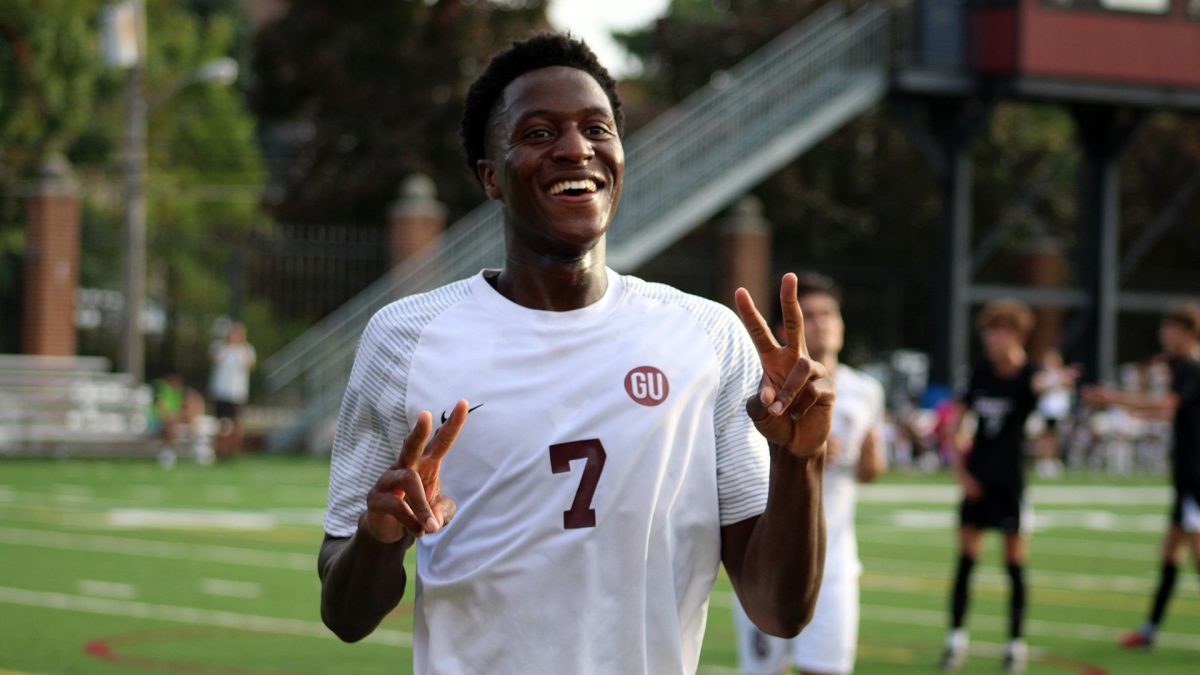Beep, beep, beep! It is 5 a.m. and the alarm is going off. You let out a big sigh as you look at your phone and hit the alarm to stop. After lying in bed for another couple minutes planning the next time you can take a nap, it is time to get up. You brush your teeth, grab a granola bar and your water bottle and head to the pool. As you sleepily walk over, you try to prepare yourself for the freezing cold water and hard workout that is about to come.
This is the typical morning for a college swimmer. Your day consists of practice then classes and then some more practice. Every minute during the day counts.
Jill Pritchard, a swimmer at Gannon University, noted how important time management was.
“College swimming makes my day-to-day life a lot busier,” she said. “Swimming helps me with my time management since I have less time to complete tasks or to study.”
Time management as a swimmer is very important, especially in college. Take an average college student’s busy day of classes and homework and then add on two to four hours of intense practice.
Although everyone wishes for more time in the day, swimmers know how to make the most out of the 24 hours they receive. At least they have to or there is the possibility of them falling far behind in their classes.
Pritchard said incoming freshmen are required to attend study tables for at least the first semester. Study tables are set times provided by the athletic department that you must attend six hours a week.
You can also attend STEM pass, the Writing Center, any tutoring or meeting with professors as part of the six hours per week as well. If freshmen achieve higher than a 3.0 GPA then they are exempt from them for the rest of their college career.
However, as a student-athlete, if your GPA falls below a 3.0 then you are required to attend study tables again for each semester until you achieve a 3.0 or higher.
During off season, Pritchard said her life is a lot less hectic.
“I have a lot more time to do everyday activities and I am actually able to nap,” she said. “I am able to stay more ahead on my assignments since I have more time and less to worry about and keep track of.”
Being a college swimmer, no matter what division you are in, is no easy task. Teddy Wassell, who was a swimmer at Allegheny College, also recalled how busy his schedule was.
“It was a difficult balance for the two years that I swam in college,” he said. “Managing athletics and a rigorous academic schedule was tough.”
Wassell said he managed to do this by making goals for himself on what he wanted to accomplish each day.
“I always tried to schedule out my days and plan when I needed to study, when I had practice and when I had free time for myself,” he said. “After a couple weeks into each semester, I had a pretty solid routine down that I tried to stick to.”
Allegheny is an NCAA Division III school, while Gannon is Division II. Both Pritchard and Wassell said they believe that these two athletic divisions are similar.
“I wouldn’t say there is a huge difference because all student-athletes are treated as student-athletes,” Pritchard said. “Between Division II and Division III, the only major difference is Division III does not provide athletic aid to student-athletes.”
Pritchard gives these Division III athletes a lot of credit because they are doing it purely out of the joy of swimming.
Wassell agreed that there is no big difference between being a Division III and a Division II swimmer.
“We swam against a few Division II teams that we either beat, or lost to in a close meet,” he said. “I think most swimming programs have morning and afternoon practices, and although many Division II teams would beat Division III teams, the quality of talent is very comparable in my opinion.”
Anita Peduto used to swim for Westminster College, a Division III school, for a year before transferring to Gannon, where she swam for her remaining three years. She also agreed with Wassell and Pritchard that there is not a big difference between the divisions.
“The only difference legally is financial aid and when the team can legitimately begin practices under the NCAA,” she said. “No matter what team or division you participate for, every coach’s training style is different.”
The Gannon swim team practices six days week. On Mondays, the team is in the pool from 2-4 p.m. Tuesdays and Thursdays there are double practices, meaning there is practice both in the morning and at night. The team lifts for an hour from 5:30-6:30 a.m. and then heads to the pool to swim from 6:30-7:30 a.m. Then from 6-8 p.m. at night there is an evening swim practice.
On Wednesdays and Fridays, swim practice is in the morning from 7-9 a.m. Finally, to wrap up the week, Saturday morning practices are from 8-11 a.m. These practices consist of swimming and being in the classroom. In the classroom, the swimmers reviews videotapes from past meets or from professional swimmers with their coach to go over proper technique.
However, when the team was preparing for the Pennsylvania State Athletic Conference Championships, which are currently happening now through Saturday in York, practices were a little different. Both morning practice and lifting sessions were cut back. The intensity of the practices also went down significantly to properly prepare and rest the body, so the swimmers could perform their absolute best.
After the first day of competition Wednesday, Gannon’s men sat in third place while the women’s team was seventh.
The men’s 800-yard freestyle relay team of Robert Bolmanski, Thomas Marshall, Joseph Deemer and Brent Benedict finished second with a school-record mark of 6 minutes, 51.22 seconds.
The Knights’ 200-yard medley relay team also shattered the Gannon record with a mark of 1:32.31, good for third place. The quartet featured Jon Ekas, Luke Engel, Allan Collins and Benedict.
Bolmanski finished fourth in the 1,000 freestyle and Benedict wound up fourth in the 50 free. On the women’s side, Silvija Taraska finished fifth in the 50 free and Gannon’s 800 free relay team of Allison Ahl, Celia Kottakis, Courteney Hubert and Taraska wound up fourth.
Allegheny’s practice schedule was very comparable to Gannon’s regular-season regimen. Morning practice for student-athletes there would be from 6-7:30 a.m. three or four days a week. Afternoon practice would be from 5-7 p.m. Monday through Friday, and Saturday morning practice would go for two to three hours.
The only thing that would affect the practice schedule would be meets. Meets occur on most Fridays and Saturdays from the beginning of October to the end of January.
In addition to practices and meets, swimming really affects overall college life in general. Pritchard said that there are special rules that you have to follow when it comes to drinking. She said there is a 24-hour rule that means you cannot consume alcohol 24 hours before a practice and a 48-hour rule that means you cannot consume alcohol 48 hours before a meet. If you get caught then you will receive punishment by either the coach or captains.
Pritchard also said how jealous she gets of “regular” students.
“They have a lot more time to finish assignments, to study or to do regular day-to-day activities,” she said.
With such an intense practice schedule and meet season, swimmers have a long season that lasts for a good portion of the year. Darren Suroviec, the head swimming and diving coach at Gannon, mentioned how he identifies more ways to keep his swimmers motivated each year.
“I have learned to be more generous with encouragement and positive reinforcement,” he said. “The two ways to keep athletes engaged is to have fun and to improve. Those are the best ways to motivate.
“I have been trying to change up sets as much as I can every day, and say something new at every practice even if it is just a quote I like. I am working on getting the culture to be why we do what we do, instead of just what we do. I think establishing a ‘why’ will help us grow.”
He also said that he tried to add more training aids into practice to ensure that there is a variety of approaches. Also to keep practices fun, he tried to do more relays.
Not only do the swimmers have a tough schedule, but coaches do too. Suroviec said his typical day is a mix of planned meetings, practices and events as well as daily surprises. Planned things are administrative work, emails, scheduling, travel plans, etc. and unplanned things are team issues, kids dropping in to talk, kids being sick and equipment breaking.
“Sometimes there are little freedoms throughout the day as a coach, but on the other hand, sometimes the hours are extremely long,” Suroviec said.
Suroviec attended Edinboro University, where he swam all four years. “I greatly prefer being a college swimmer,” he said. “Being a college coach is much different than one would expect.”
Suroviec said the pressures of being a college swim coach are so great because you feel responsible for everyone and how they do. When people do not perform how they want, often the coach feels a lot of the blame.
Pritchard and Wassell agreed that there is a strong love-hate relationship when it comes to swimming.
“Practices are not the best all of the time, you’re tired 90 percent of the time, your life is consumed by the sport but when you are competing and you reach that one goal you have been working so hard for and dreaming about for months, it validates everything you have gone through,” Pritchard said.
“That feeling you get when you win a big race or get a new best time makes everything worth it,” Wassell said. “That feeling makes you realize why you fell in love with this sport.”
Both Wassell and Pritchard also said that because you spend so much time with your teammates, they naturally become your second family.
“Even though it takes a lot to be a student-athlete, I wouldn’t give it up,” Pritchard said, “and I already know I will be heartbroken when I finally retire as an athlete and officially become a NARP (non-athletic regular person).”
Mary Wassell











